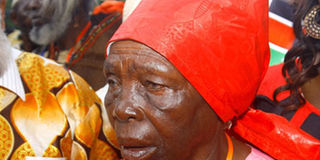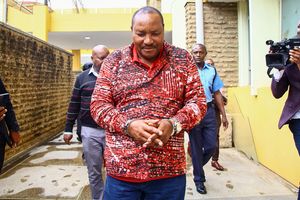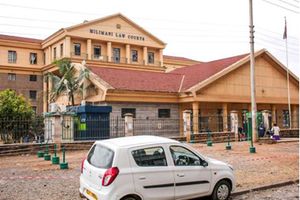Premium
Mau Mau insiders helped the British capture Kimathi

Freedom fighter Dedan Kimathi Mokami's widow (centre) during Mashujaa day at Nyayo National Stadium on October 20 2012. Photo/DANIEL IRUNGU.
What you need to know:
- A pseudo-gang is an undercover operation where troops infiltrate enemy ranks, then use their insider knowledge to bring down the group.
- The tactic is much easier when the pseudo-gang members are former enemy fighters.
The pseudo-gang technique as a counter-insurgency was perfected in Kenya during the State of Emergency.
Initially spontaneous, the tactic ended up playing a big role in defeating the Mau Mau, with its biggest catch being the most wanted man at the time, Dedan Kimathi Waciuri.
A pseudo-gang is an undercover operation where troops infiltrate enemy ranks, then use their insider knowledge to bring down the group.
It relies heavily on the breaks in communication among fighting groups, especially where the large number of fighters makes it impossible for each member to know everyone else.
The tactic is much easier when the pseudo-gang members are former enemy fighters. The information they have is more authentic. The use of pseudo-gangs to bring down the Mau Mau took this form.
The gangs and forces comprised European officers, African constables, and some Mau Mau members. The European officers took extra precaution to blend in with the gangs.
THEIR HAIR WAS AN OBVIOUS GIVEAWAY
They used potassium permanganate solution, boot polish, and burnt cork to achieve a believable complexion, including a weaker solution for the eyes to achieve a yellow coloration.
According to Leroy Thompson in The Use of Pseudo-Gangs Against the Mau Mau, they sorted out the most obvious giveaway — their hair — with wigs made from the hair of fallen Mau Mau fighters.
Major Frank Kitson, a colonial military officer in Kenya at the time, first heard of the pseudo-gang idea in March 1954.
An intelligence officer called Hales had been roaming the jungle with his African helpers when they bumped into a gang of Mau Mau fighters. Hales crouched away from the group, and his assistants pretended to be a Mau Mau fighting unit.
They got away with it.
Kitson writes about one particular ex-Mau Mau fighter called James: “On one or two occasions, however, he had been released and had gone back to groups of terrorists who did not know that he was a prisoner. He had then been able to give the FIA concerned accurate information as to exactly where they were. Once he took command of a small group of Mau Mau, which he found, and led it into an ambush.”
Such stories abound, although none of the surviving former Mau Mau fighters will confess to having fought in the pseudo-gangs.
It was Ian Henderson, nicknamed Kinyanjui, who perfected a technique that had been developed in Palestine and Malaya. “It was in Kenya that they were formalised into a highly successful counter-insurgent tactic,” writes Leroy.
The biggest success for the pseudo-gang tactic was the capture of Dedan Kimathi. It started when a fighter called Hungu and his colleague, Gati, escaped before the former could be punished for engaging in coital activities.
The two offered themselves up to Henderson to save their own skin from Kimathi’s wrath. Henderson quickly recruited them into one of his pseudo-gangs dedicated to finding Kimathi.
They became his contacts for other recruits. Within no time, Kimathi was on a stretcher to hospital with bullet wounds and the Mau Mau was on its deathbed, catalysed by former members of its ranks.




